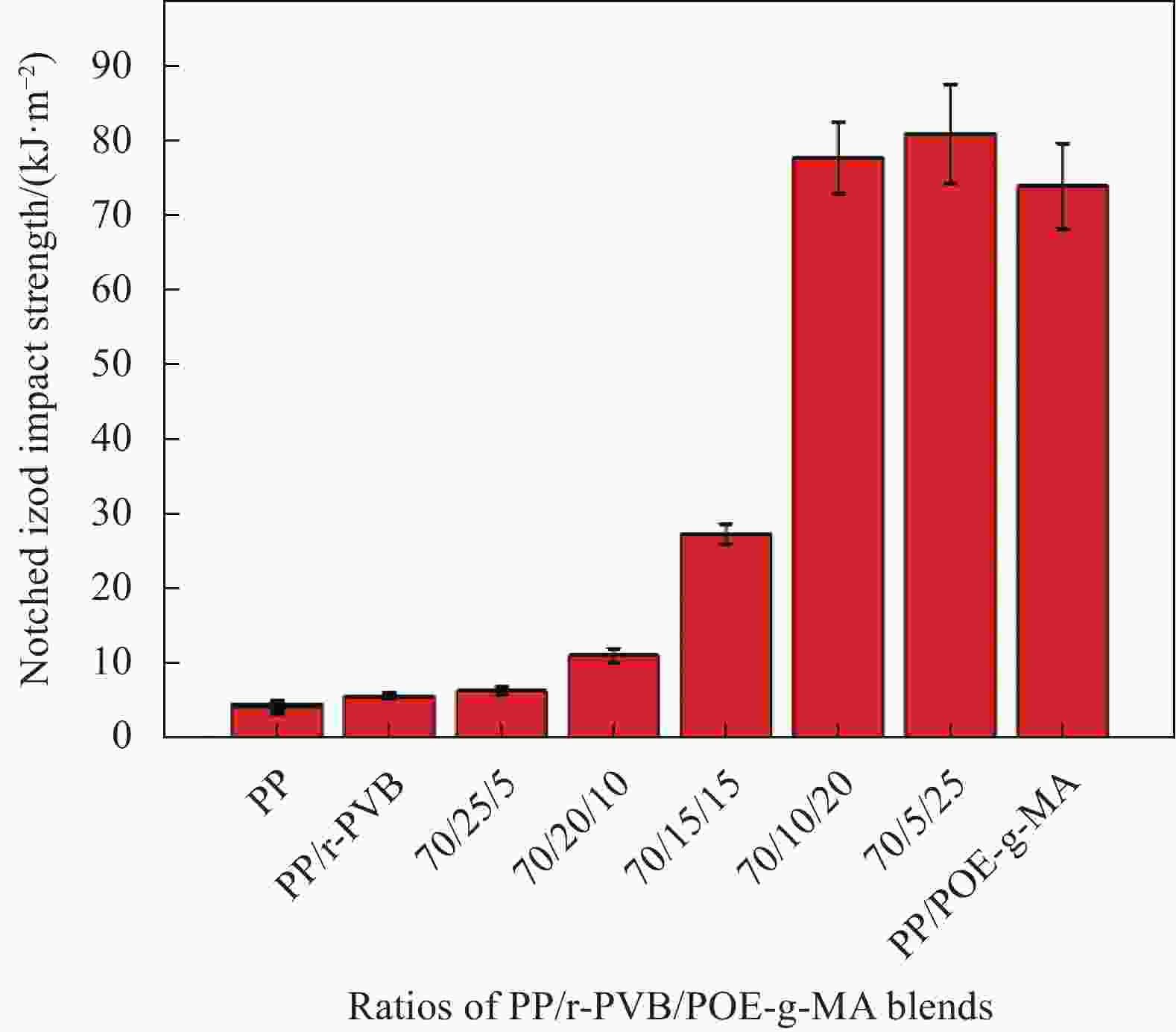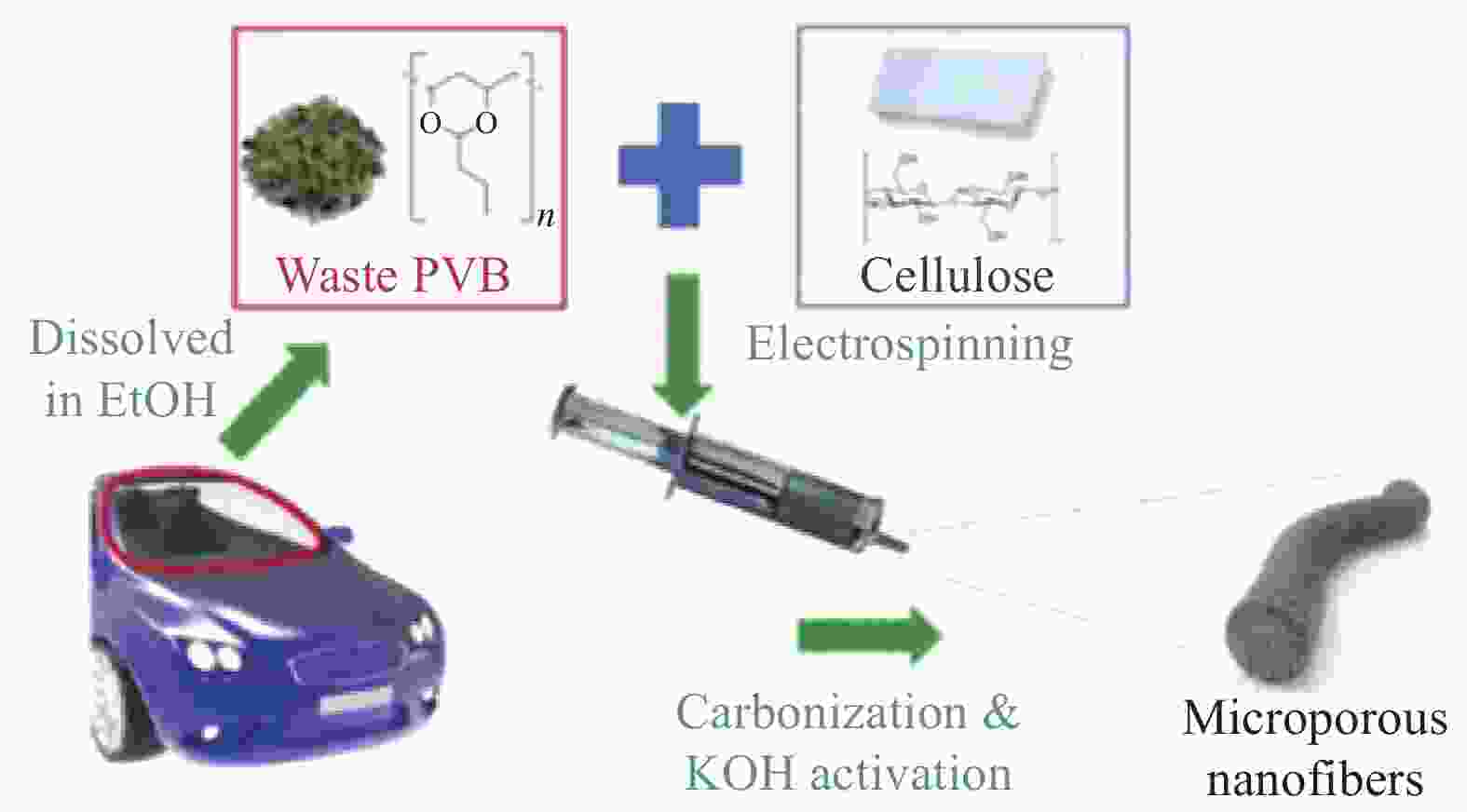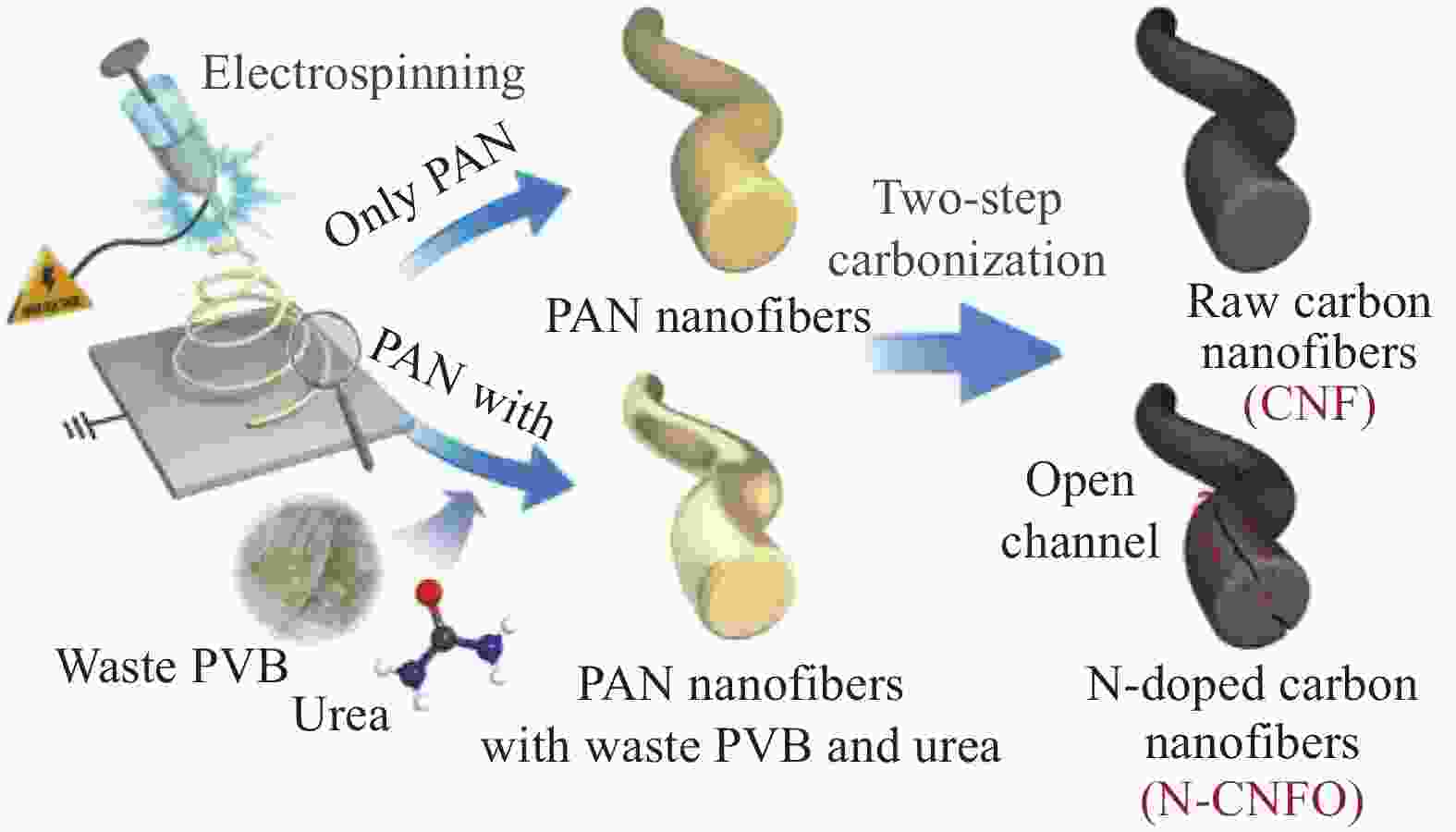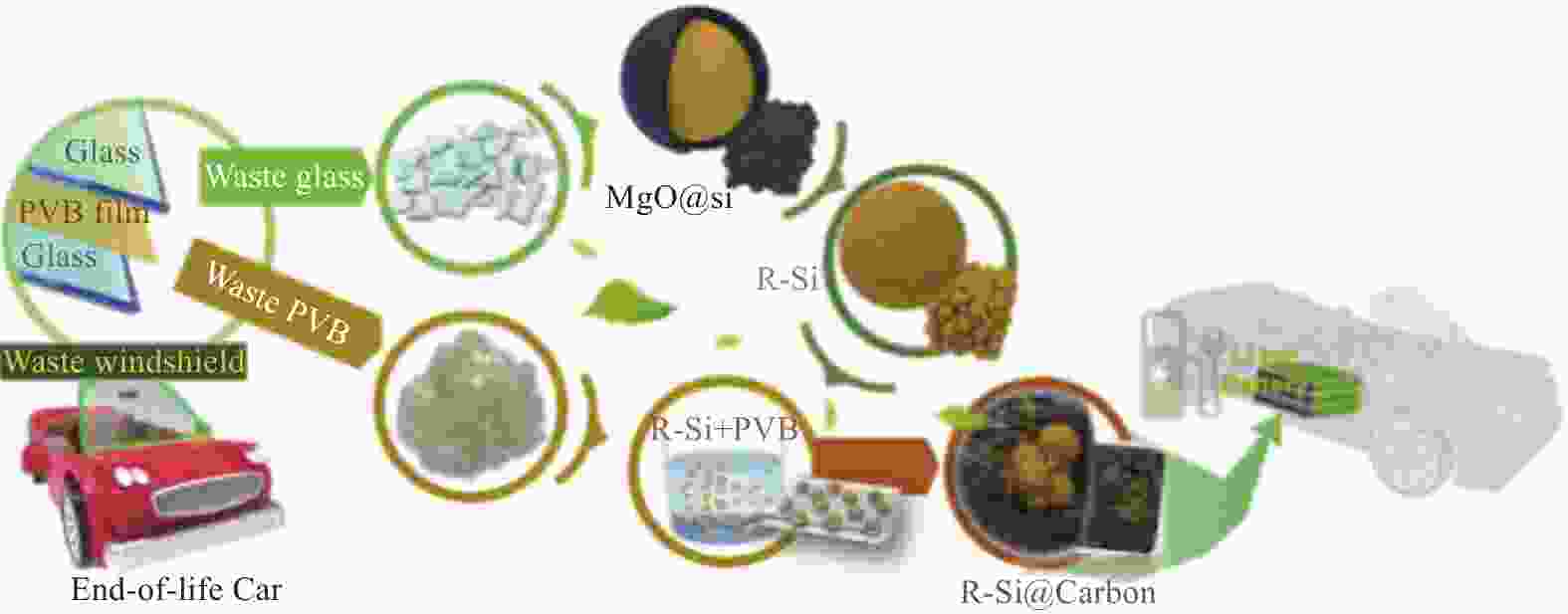Research progress on the recycling and reuse of waste polyvinyl butyral
-
摘要: 聚乙烯醇缩丁醛(PVB)树脂具有优异的成膜性、光学透明度及较强的柔韧性、弹性、粘结性、抗冲击等性能,广泛应用于陶瓷花纸、涂料、粘合剂、汽车挡风玻璃夹层材料、太阳能电池封装材料等领域,但PVB呈现不可降解特性,大量的废旧PVB树脂产出极易造成资源浪费和环境污染。如何实现废旧PVB树脂的回收和再利用是当前工程领域内的研究热点。本文简要介绍了PVB树脂的特性及废旧PVB树脂的来源,详细阐述了废旧PVB树脂的回收技术,例举了再生PVB树脂在过滤材料、吸附材料、增韧材料、发泡材料以及电化学材料中的应用现状,综述内容为废旧PVB树脂的回收再利用提供了参考。Abstract: Polyvinyl butyral (PVB) resin has excellent film-forming properties, optical transparency, strong flexibility, elasticity, adhesion, and impact resistance. It is widely used in ceramic flower paper, coatings, adhesives, automotive windshield interlayer materials, solar cell packaging materials, and other fields. However, PVB exhibits non degradable characteristics, and the production of a large amount of waste PVB resin is prone to resource waste and environmental pollution. How to achieve the recovery and reuse of waste PVB resin is a research hotspot in the current engineering field. This article briefly introduces the characteristics of PVB resin and the sources of waste PVB resin, elaborates on the recycling technology of waste PVB resin, and provides examples of the application status of regenerated PVB resin in filtration materials, adsorption materials, toughening materials, foaming materials, and electrochemical materials. The review provides a reference for the recycling and reuse of waste PVB resin.
-
Key words:
- waste PVB resin /
- non-degradable /
- waste recycling /
- reuse /
- application status
-
表 1 四种不同的废旧PVB回收技术的优缺点
Table 1. Advantages and disadvantages of four different waste PVB recycling technologies
The source of waste PVB Recycling technology for waste PVB Technical advantages Technical disadvantages Mechanochemical separation technology
(wet process)1. Water based media can effectively wash glass and other pollutants, reducing dust. 2. The filtrate can be reused as a separation medium to achieve recycling. 3. The application of water or some environmentally friendly solvents can reduce pollution. 1. There are many types of organic solvents, most of which are toxic and prone to causing environmental pollution. 2. The noise generated during the mechanical separation process is relatively high. 80% of the world's high viscosity waste PVB film comes from safety glass laminates Mechanical thermodynamic separation technology (dry process) 1. Avoiding the application of harmful organic solvents. 1. It is difficult to remove and filter the glass debris after mechanical separation, and more glass dust is generated. 2. This process requires strict temperature control, as PVB will decompose and lead to a decrease in recovery rate. 3. The noise is loud. Mechanochemical separation technology assisted thermodynamics (dry wet combined process) 1. The dual effects of chemistry and thermodynamics result in relatively less noise generated during the separation process. 2. The combination method reduces the viscosity between PVB and glass, weakens the mechanical properties, and improves the separation efficiency. 3. There is more hope to achieve large-scale recycling of waste PVB. 1. The cost is relatively high. 2. The process flow is more complex. The remaining 20% or so come from low viscosity waste PVB colored plastics in adhesives, coatings, and ceramic flower paper Solvent dissolution vacuum distillation technology 1. This method can effectively decolorize the blue black PVB film into a colorless film. 2. The reagents, pigments, and plasticizers after decolorization can be recycled and reused. High recycling efficiency and low cost. 1. The vacuum distillation method generates high energy consumption during heating, takes a long time, and has a complex process. 2. Pressure is difficult to control stably, and improper pressure control can lead to distillation failure and incomplete purification. -
[1] 高歌. 聚乙烯醇缩丁醛的合成及应用[J]. 化工设计通讯, 2018, 44(9): 12-13.GAO Ge. Synthesis and Application of Polyvinyl Butyral[J]. Chemical Engineering Design Communications, 2018, 44(9): 12-13(in Chinese). [2] 李润航. 聚乙烯醇缩丁醛(PVB)的制备 [D]. 上海: 上海应用技术大学, 2020.LI Runhang. Preparation of polyvinyl butyral (PVB) [D]. Shanghai: Shanghai Institute of Technology, 2020(in Chinese). [3] SONEGO M, COSTA L C, AMBROSIO J D, et al. Polyvinyl butyral chemically modified with a silane agent in the molten state[J]. Polymer Engineering & Science, 2016, 56: 971-979. [4] 钟建永. 聚乙烯醇缩丁醛老化研究 [D]. 厦门: 厦门大学, 2019.ZHONG Jianyong. Study on the Aging of Polyvinyl Butyral [D]. Xiamen: Xiamen University, 2019(in Chinese). [5] 李宇. 新型无皂聚合制备PVB树脂及其应用研究 [D]. 长春: 长春工业大学, 2020.LI Yu. Research on the Preparation of PVB Resin by Novel Soap-Free Polymerization Technology and Its Application [D]. Changchun: Changchun University of Technology, 2020(in Chinese). [6] WANG H, XIE C, YU W T, et al. Efficient combined method of selective dissolution and evaporation for recycling waste polyvinylbutyral films[J]. Plastics, Rubber and Composites, 2013, 41(1): 8-12. [7] 苏一轩, 王玲玲, 段婷婷, 等. 高PVB含量改性酚醛树脂薄膜的制备及性能[J]. 工程塑料应用, 2023, 51(5): 37-44.SU Yixuan, WANG Lingling, DUAN Tingting, et al. Preparation and Properties of Modified Phenolic Resin Film with High PVB Content[J]. Engineering Plastics Application, 2023, 51(5): 37-44(in Chinese). [8] 苏一轩, 王玲玲, 闫少谦, 等. 酚醛/聚乙烯醇缩丁醛树脂体系的阻燃改性成膜研究[J]. 化工新型材料, 2023, 51(6): 114-119+124.SU Yixuan, WANG Lingling, YAN Shaoqian, et al. Study on flame retardant modification and film forming property of phenolic/polyvinyl butyral resin[J]. New Chemical Materials, 2023, 51(6): 114-119+124(in Chinese). [9] KROLIKOWSKI M, ZACH P, KALESTYNSKI M, et al. Selection of Conditions in PVB Polymer Dissolution Process for Laminated Glass Recycling Applications[J]. Polymers, 2022, 14(23): 5119-5137. doi: 10.3390/polym14235119 [10] 林成辉. 高速成长中的塑料新材料PVB树脂的性能及应用[J]. 轻工科技, 2019, 35(8): 44-45.LIN Chenghui. The properties and applications of PVB resin, a rapidly growing new plastic material[J]. Guangxi Journal of Light Industry, 2019, 35(8): 44-45(in Chinese). [11] 张萍. 废旧PVB膜片与MF树脂、CaCl2·nH2O的熔融交联反应及发泡性质研究 [D]. 郑州: 郑州大学, 2018.ZHANG Ping. Study on melt cross-linking reactions of waste PVB films with MF resin and CaCl2·nH2O as well as their foaming properties [D]. Zhengzhou: Zhengzhou University, 2018(in Chinese). [12] ŠOOS L, MATUS M, POKUSOVA M, et al. The Recy cling of Waste Laminated Glass through Decomposition Technologies[J]. Recycling, 2021, 6(2): 26-39. doi: 10.3390/recycling6020026 [13] SWAIN B, PARK J R, SHIN D Y, et al. Recycling of waste automotive laminated glass and valorization of polyvinyl butyral through mechanochemical separation[J]. Environmental Research, 2015, 142: 615-623. doi: 10.1016/j.envres.2015.08.017 [14] JANG Y C, CHOI K, JEONG J h, et al Recycling and Material-Flow Analysis of End-of-Life Vehicles towards Resource Circulation in South Korea[J]. Sustainability, 2022, 14 (3): 1270. [15] KHOURI S, BEHUN M, KNAPCIKOVA L, et al. Charac terization of Customized Encapsulant Polyvinyl Butyral Used in the Solar Industry and Its Impact on the Environment[J]. Energies, 2020, 13(20): 5391-5409. doi: 10.3390/en13205391 [16] CHANNA I A, CHANDIO A D, RIZWAN M, et al. Solu tion Processed PVB/Mica Flake Coatings for the Encapsulation of Organic Solar Cells[J]. Materials 2021, 14(10): 2496-2510. [17] 董穆, 姚雪容, 张江茹, 等. 太阳能电池封装胶膜技术研究进展[J]. 石油化工, 2023, 52(7): 992-999.DONG Mu, YAO Xuerong, ZHANG Jiangru, et al. Research progress in encapsulants of solar modules[J]. Petrochemical Technology, 2023, 52(7): 992-999(in Chinese). [18] HUANG X, LIN Y, FANG G. Thermal properties of polyvinyl butyral/graphene composites as encapsulation materials for solar cells[J]. Solar Energy, 2018, 161: 187-193. doi: 10.1016/j.solener.2017.12.051 [19] YANG K-Y, KIM J, CHO H K, et al. Environment-stable solar window modules encapsulated with UV-curable transparent resin[J]. Solar Energy, 2017, 158: 528-532. doi: 10.1016/j.solener.2017.10.002 [20] GAVRILUTA A, FIX T, NONAT A, et al. Enhancement of Copper Indium Gallium Selenide Solar Cells Using Europium Complex as Photon Downshifter[J]. Advanced Optical Materials, 2016, 4(11): 1846-1853. doi: 10.1002/adom.201600395 [21] 张建伦. 碳纳米管/氧化锌晶须/聚乙烯醇缩丁醛复合材料导热性能的实验研究 [D]. 青岛: 青岛理工大学, 2019.ZHANG Jianlun. Experimental Study on Thermal Conductivity of MwCNT/T-ZnOw/PVB Compo sites [D]. Qingdao: Qingdao University of Technology, 2019(in Chinese). [22] 严欣兵. 小分子交联剂与橡胶对废旧PVB膜片的改性研究[D]. 郑州: 郑州大学, 2012.YAN Xinbing. Study on modification of waste PVB flm with small molecule cross-linker and rubber [D]. Zhengzhou: Zhengzhou University, 2012(in Chinese). [23] NIKITAKOS V, PORFYRIS A. D, BELTSIOS K, et al. An Integrated Characterization Strategy on Board for Recycling of poly(vinyl butyral) (PVB) from Laminated Glass Wastes[J]. Polymers 2023, 16(1): 10-31. [24] HE Q, MEI E, LIANG X , et al. Ultrastable PVB films-protected CsPbBr3/Cs4PbBr6 perovskites with high color purity for nearing Rec. 2020 standard[J]. Chemical Engineering Journal , 2021, 419: 129529. [25] 谢畅. 废旧PVB塑料回收再生技术研究 [D]. 长沙: 中南大学, 2010.XIE Chang. Research on the recycling and regeneration technology of waste PVB plastics [D]. Changsha: Central South University, 2010(in Chinese). [26] TUPY M, MOKREJS P, MERINSKA D, et al. Windshield recycling focused on effective separation of PVB sheet[J]. Journal of Applied Polymer Science, 2013, 131(4): 39879. [27] 于婉婷. 废旧聚乙烯醇缩丁醛塑料脱色技术研究 [D]. 长沙: 中南大学, 2008.YU Wanting. Research on decolorization technology of waste polyvinyl butyral plastics [D]. Changsha: Central South University, 2008(in Chinese). [28] SWAIN B, PARK J R, LEE C G. Industrial recycling of end-of-life vehicle windshield glass by mechanical beneficiation and complete recovery of polyvinyl butyral[J]. Journal of Cleaner Production, 2022, 334: 130192. doi: 10.1016/j.jclepro.2021.130192 [29] LI Y, YU T, PUI T, et al. Fabrication and character ization of recyclable carbon nanotube/polyvinyl butyral composite fiber[J]. Composites Science and Technology, 2011, 71(14): 1665-1670. doi: 10.1016/j.compscitech.2011.07.018 [30] LUBASOVA D, MARTINOVA L. Controlled Morpholo gy of Porous Polyvinyl Butyral Nanofibers[J]. Journal of Nanomaterials, 2011, 2011: 1-6. [31] MERINSKA D, TUPY M, KASPARKOVA V, Deg radation of Plasticized PVB During Reprocessing by Kneading[J]. Macromolecular bioscience, 2009, 286 : 107-115. [32] 张子阳, 陈洪军, 孙荣华, 等. 高黏度聚乙烯醇缩丁醛树脂的研究进展[J]. 精细石油化工, 2024, 41(1): 79-82.ZHANG Ziyang, CHEN Hongjun, SUN Ronghua, et al. Research Progress of High Viscosity Polyvinyl Butyral Resin[J]. Speciality Petrochemicals, 2024, 41(1): 79-82(in Chinese). [33] 张嘉良. 功能化二氧化硅纳米颗粒改性PVB性能研究 [D]. 郑州: 郑州大学 2022.ZHANG Jialiang. Study on PVB Performance Modified by Functionalized Silica Nanoparticles [D]. Zhengzhou: Zhengzhou University, 2022(in Chinese). [34] 王瑞. 高抗冲聚烯烃/废旧PVB膜片共混材料制备与研究 [D]. 郑州: 郑州大学, 2020.WANG Rui. Preparation and Research of Polyolefin/Residue of PVB Film Blending Materials with High Toughness [D]. Zhengzhou: Zhengzhou University, 2020(in Chinese). [35] 魏子朕. 具有“多核结构”的超韧PA6/r-PVB/POE-g-MA共混物的制备与研究 [D]. 郑州: 郑州大学, 2020.WEI Zizhen. Preparation and Research of Super-Toughened PA6/r-PVB/POE-g-MA Blends with “Multicore Structure” [D]. Zhengzhou: Zhengzhou University, 2020(in Chinese). [36] 张丽青, 张国利, 王伟伟, 等. 聚乙烯醇缩丁醛改性酚醛树脂的耐热与增韧性能[J]. 高分子材料科学与工程, 2021, 37(6): 85-93.ZHANG Liqing, ZHANG Guoli, WANG Weiei, et al. Heat resistance and toughening properties of polyvinyl butyraldehyde modified phenolic resin[J]. Polymer Material Science and Engineering, 2021, 37(6): 85-93(in Chinese). [37] 曹艳霞, 崔蒙蒙, 李迪, 等. 回收聚乙烯醇缩丁醛/二氧化硅复合材料的制备与性能研究[J]. 高分子通报, 2015, 1(8): 44-49.CAO Yanxia, CUI Mengmeng, LI Di, et al. Research on the Preparation and Properties of Recycled PVB/SiO2 Composites by Melt Blending[J]. Polymer Bulletin, 2015, 1(8): 44-49(in Chinese). [38] 郑学晶, 王影霞, 刘小凡, 等. 剑麻微纤维/回收聚乙烯醇缩丁醛复合材料的制备与性能[J]. 复合材料学报, 2014, 31(4): 902-908.ZHENG Xuejing, WANG Yingxia, LIU Xiaofan, et al. Preparation and properties of sisal microfibrils/recycled polyvinyl butyral composites[J]. Acta Materiae Compositae Sinica, 2014, 31(4): 902-908(in Chinese). [39] ZANJANIJAM A R, HAKIM S, AZIZI H. Morphologi cal, dynamic mechanical, rheological and impact strength properties of the PP/PVB blends: the effect of waste PVB as a toughener[J]. RSC Advances, 2016, 6(50): 44673-44686. doi: 10.1039/C6RA04143D [40] WU Y, HUANG K, WENG X, et al. PVB coating effi ciently improves the high stability of EMI shielding fabric with Cu/Ni[J]. Advanced Composites and Hybrid Materials, 2022, 5(1): 71-82. doi: 10.1007/s42114-021-00401-2 [41] 汪国慧, 侯栋梁, 章淑娟, 等. 马来酸酐改性聚乙烯醇缩丁醛的制备及其在光固化涂层中的应用[J]. 现代纺织技术, 2023, 31(6): 188-198.WANG Guohui, HOU Dongliang, ZHANG Shujuan, et al. Preparation of maleic anhydride-modified polyvinyl butyral and its application in blue light curing coatings[J]. Advanced Textile Technology, 2023, 31(6): 188-198(in Chinese). [42] 李春艳, 李小瑞, 沈一丁, 等. 水性聚乙烯醇缩丁醛的合成及应用[J]. 造纸科学与技术, 2021, 40(4): 10-17.LI Chunyan, LI Xiaorui, SHEN Yiding, et al. Synthesis and Application of Water-based Polyvinyl Butyral[J]. Paper Science & Technology, 2021, 40(4): 10-17(in Chinese). [43] BRENDGEN R, GRAßMANN C, GRETHE T, et al. Coat ings with recycled polyvinyl butyral on polyester and polyamide mono- and multifilament yarns[J]. Journal of Coatings Technology and Research, 2021, 18(3): 819-829. doi: 10.1007/s11998-020-00445-x [44] YAO, H. , ZHANG, X. , SHEN, L. , BAO, N. Tribological and anticorrosion properties of polyvinyl butyral (PVB) coating reinforced with phenol formaldehyde resin (PF). Progress in Organic Coatings 2021, 158, 106382. [45] CARMONA-CERVANTES I A, PAREDES-MOGICA E A, LOPEZ-CABRERA H R, et al. Tribological behavior of glass fiber reinforced polyamide (PA-GF) and recycled polyvinyl butyral (r-PVB) blends[J]. Materials Letters, 2022, 319: 132261. doi: 10.1016/j.matlet.2022.132261 [46] 张国栋. AC/NaHCO3复合发泡剂的改性及在PVB发泡材料中的应用研究 [D]. 郑州: 郑州大学 2013.ZHANG Guodong. Study on modification of AC/NaHCO3 comprund foaming agent and its application in PVB foaming material [D]. Zhengzhou: Zhengzhou University, 2013(in Chinese). [47] 朱能贵, 熊一鸣, 蒋团辉, 等. 聚合物发泡材料成型装备应用研究进展[J]. 现代塑料加工应用, 2023, 35(5): 43-46.ZHU Nenggui, XIONG Yiming, JIANG Tuanhui, et al. Research Progress in Application of Forming Equipment for Polymer Foaming Material[J]. Modern Plastics Processing and Applications, 2023, 35(5): 43-46(in Chinese). [48] 曹艳霞, 张萍, 张国栋, 等. 聚乙烯醇缩丁醛发泡材料的制备及性能影响因素[J]. 化学推进剂与高分子材料 2016, 14(1): 55-58.CAO Yanxia, ZHANG Ping, ZHANG Guodong, et al. Preparation and performance influencing factors of polyvinyl butyral foaming materials[J]. Chemical Propellants & Polymeric Materials, 2016, 14(1): 55-58. [49] DONG M, WANG G, ZHANG X, et al An overview of polymer foaming assisted by supercritical fluid[J]. Advanced Composites and Hybrid Materials, 2023, 6(6): 207-229. [50] GUNER B, BULBUL Y E, DILSIZ N. Recycling of pol yvinyl butyral from waste automotive windshield and fabrication of their electrospun fibrous materials[J]. Journal of the Taiwan Institute of Chemical Engineers, 2022, 132: 104136. doi: 10.1016/j.jtice.2021.11.003 [51] 王玲, 任笑鸽, 马鸣, 等. PVB微纳米纤维膜的制备及其口罩应用研究[J]. 化工新型材料, 2022, 50: (1) 434-438+443.WANG Ling, REN Xiaoou, MA Ming, et al. Preparation of PVB micro-nanofiber membrane and its application in masks [J] New chemical materials, 2022, 50: (1) 434-438+443(in Chinese). [52] 施静雅, 王慧佳, 易雨青, 等. 聚氨酯/聚乙烯醇缩丁醛复合纳米纤维膜的制备及其过滤性能[J]. 纺织学报, 2023, 44(8): 26-33.SHI Jingya, WANG Jiahui, YI Yuqing, et al. Preparation and filtration of polyurethane/polyvinyl butyral composite nanofiber membrane[J]. Journal of Textile Research, 2023, 44(8): 26-33(in Chinese). [53] LOU Z, WANG L, YU K, et al. Electrospun PVB/AVE NMs as mask filter layer for win-win effects of filtration and antibacterial activity[J]. Journal of Membrane Science, 2023, 672: 121473. doi: 10.1016/j.memsci.2023.121473 [54] PARK J C, KIM J-C, PARK S, et al. Efficient waste polyvinyl(butyral) and cellulose composite enabled carbon nanofibers for oxygen reduction reaction and water remediation[J]. Applied Surface Science, 2020, 510: 145505. doi: 10.1016/j.apsusc.2020.145505 [55] FILIP P, SEDLACEK T, PEER P, et al. Electrospun Sound-Absorbing Nanofibrous Webs from Recycled Poly(vinyl butyral)[J]. Polymers, 2022, 14 : (22) 5049 [56] PARK S-W, KIM J-C, DAR M A, et al. Superior lith ium storage in nitrogen-doped carbon nanofibers with open-channels[J]. Chemical Engineering Journal, 2017, 315: 1-9. doi: 10.1016/j.cej.2017.01.005 [57] PARK S. -W, KIM J-C, DAR M A, et al. Enhanced cycle stability of silicon coated with waste poly(vinyl butyral)-directed carbon for lithium-ion battery anodes[J]. Journal of Alloys and Compounds, 2017, 698: 525-531. [58] CHOI M, KIM J-C, KIM D-W. Waste Windshield-Derived Silicon/Carbon Nanocomposites as High-Performance Lithium-Ion Battery Anodes[J]. Scientific Reports, 2018, 8(1): 960-972. doi: 10.1038/s41598-018-19529-1 -

 点击查看大图
点击查看大图
计量
- 文章访问数: 54
- HTML全文浏览量: 25
- 被引次数: 0





 下载:
下载:














